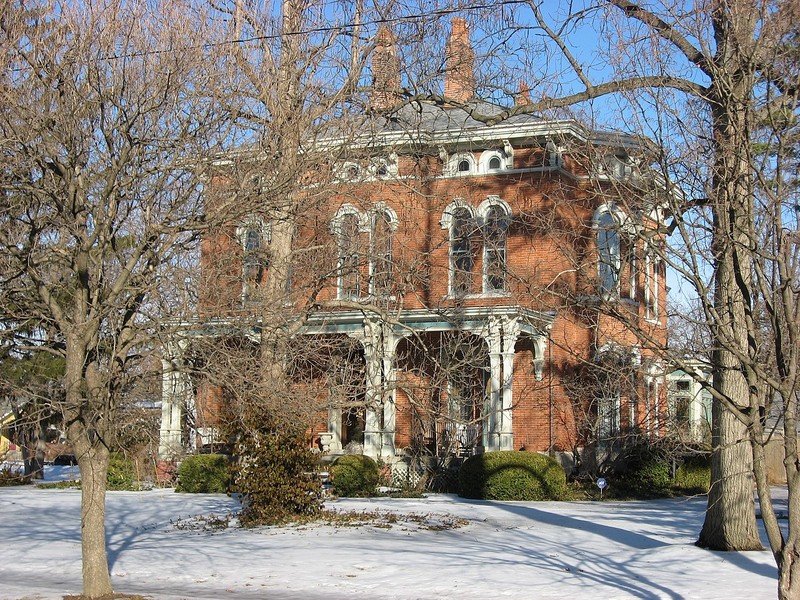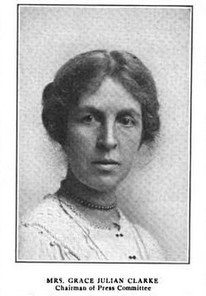Grace Julian Clarke House
Introduction
Text-to-speech Audio
Suffragist, author, and journalist Grace Julian Clarke (1865-1938), lived in this house from 1873, when it was built, until her death in 1938. Clarke was one of Indiana's leading activists of the late 19th and early 20th centuries. She was a member of many organizations including several women's clubs, was a staunch supporter of women gaining the right to vote, and co-founded the Woman's Franchise League. Clarke was a noted writer as well. She wrote a weekly column in Indianapolis Star, edited the paper's woman's page, and wrote two books about her father, George W. Julian (1817-1899), who was a lawyer, politician, and ardent supporter of women's suffrage and abolitionism. In 1868, he was the first to propose a women's suffrage amendment to the U.S. Constitution. The house was added to the National Register of Historic Places in 1986.
Images
The Grace Julian Clarke House was built in 1873. Clarke was one of the state's leading activists in the late 18th and early 20th centuries. She is best known for her work in the suffrage movement.

Grace Julian Clarke (1865-1938)

Backstory and Context
Text-to-speech Audio
Grace Julian Clarke was born on September 11, 1865 in the town of Centerville, Indiana. Her mother was Laura Giddings Julian, George W. Julian's second wife and daughter of noted politician and abolitionist Joshua Reed Giddings. Clarke had three half brothers from George's first marriage to Anne Elizabeth Finch, who died in 1860. Clarke spent her early years in Washington D.C., where George served in the U.S. House of Representatives (he served from 1849 to 1851, and from 1861 to 1871), until the family moved to Indianapolis in 1873 (at the time, where the house is now was in a suburb of Indianapolis called Irvington). George built the house at this time.
Clarke earned her bachelor of arts degree and master's degree in philosophy from Butler University in 1884 and 1885, respectively. In 1887, she married attorney Charles Clarke, who served under George as Deputy Surveyor General. At the time of their marriage, George was Surveyor General of New Mexico and was tasked with resolving land disputes. Clarke accompanied him and that's how she met Charles. Charles would later serve in the Indiana Senate in 1913 and 1915.
Clarke became active in Indiana clubs and organizations and would eventually establish a number of them by herself or with others. These included the Irvington Women's Club, a literary group that she founded in 1892 and served as its president, the Irvington Union of Clubs, and the Indiana State Federation of Women's Clubs. Clarke served as the president of the Federation from 1909-1911. She was also a board member and national press chairman of the General Federation of Women's Clubs. In 1911 she co-founded the Woman's Franchise League and became the first president of the Legislative Council of Indiana, which she also helped establish. Her name became known among women around the state in 1915 when she served as campaign manager during the Federation's presidential election. Clarke was largely responsible for revitalizing the suffrage movement in Indiana.
After the 19th Amendment was ratified in 1920, Clarke shifted her focus to international peace activism and foreign affairs. Her activities included giving speeches in support of the League of Nations and serving as a member of the National Committee of the League to Enforce Peace.
Clarke held several other positions as well. In 1916, President Woodrow Wilson appointed her as the head of the Federal Employment Bureau employment office in Indianapolis. In 1931, she was appointed to the City Planning Commission and served until 1933. She was also a member of the Marion County Board of Charities. She died on June 16, 1938. She and Charles, who died the next year, did not have children.
Many prominent individuals visited the house including suffragist Susan B. Anthony, African-American activist Sojourner Truth, and Presidents Henry Harrison and Woodrow Wilson. The house operated as a sanatorium (a long-term treatment facility) from 1945-1973. It eventually came into the possession of the Historic Landmarks Foundation. It appears to be a private residence today.
Sources
"Grace Julian Clarke." The Historical Marker Database. Accessed July 18, 2023. https://www.hmdb.org/m.asp?m=174678.
Swihart, Jackie. "A Petty Affair: Grace Julian Clarke and the 1915 Campaign for the Indiana General Federation of Women’s Clubs Presidency." Indiana History Blog. January 10, 2019. https://blog.history.in.gov/a-petty-affair-grace-julian-clarke-and-the-1915-campaign-for-the-indiana-general-federation-of-womens-clubs-presidency.
Utz, Eric et al. "Julian-Clarke House." National Park Service - National Register of Historic Places Nomination Form. June 20, 1986. https://npgallery.nps.gov/AssetDetail/NRIS/86001335.
Wright, Martha. "Grace Giddings Julian Clarke." Encyclopedia Indianapolis. 1994. Last Updated July 2021. https://indyencyclopedia.org/grace-giddings-julian-clarke.
Wikimedia Commons: https://commons.wikimedia.org/wiki/File:Julian-Clark_House.jpg
